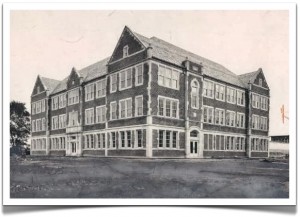In December 2012, History said goodbye to Morrill Hall and moved to the Old Horticulture Building.
Opened in 1900, Morrill Hall was first named the Women’s Building. Though women were admitted to MSU in small numbers beginning in 1870, a women’s course was not introduced until 1896. As the number of women rose, the university need a dormitory—the Women’s Building. The Dean of women had a residence on the first floor and home economics instructors lived on the upper floors. There was space for 120 women students and a dining room, cooking and sewing laboratories, a woodshop, music rooms, and a gym. According to a catalog from the day, women residents were subject “to only such restraints as would be expected in a well regulated Christian family.” By 1926, modifications allowed for the housing of 200 women in the building.
In the mid-1930s, increased enrollment in the Women’s course made necessary the construction of new dormitories. As women students moved into new buildings, Morrill Hall was converted in 1937 into classrooms and offices for the Liberal Arts Division. That year the building was officially named Morrill Hall in honor of Vermont Senator Justin Smith Morrill. He had been instrumental in forging the federal Morrill Act, which established land-grant colleges. The act was critical in the development of higher education in the United States.
As part of the Liberal Arts Division, History, along with six other departments, established itself in Morrill in 1937. As the department grew, it came to occupy all of the third and fourth floors and parts of the first floor and garden level. English occupied the second floor and Religious Studies part of the first.
About 100 years after its construction, Morrill’s age began to show. Inspections revealed deterioration in the building’s wooden infrastructure and shallow foundation. In 2010, the MSU Board of Regents decided that repairs were not feasible and approved a plan for demolition.
Events then unfolded quickly. In summer 2012, English and Religious Studies were moved from Morrill to Wells Hall. Romance
Languages, which had been in Old Horticulture, was also moved to Wells. Crews then did minor renovations on Old Hort. History was the last department to vacate Morrill during a move which took several weeks.
Morrill Hall was demolished in summer 2013. In spring 2014, the Morrill plot was transformed into a green space with benches and gardens arranged in manner so as to emulate the long, wide halls that characterized the old structure.
Needless to say, the move to Old Hort was time consuming. Faculty packed their own belongings, most of which consisted of books. Crate after crate was then taken by university movers 100 yards across campus. Faculty then unpacked their things and began the process of settling in.
Old Hort lacks some of the charm of Morrill. Gone are the high ceilings, hardwood floors, large windows looking out at the green, and spacious offices. But Old Hort has proven to have some advantages. The heating system works well, there are no rats, bats or birds inside the building, and the offices, though smaller, are comfortable and roomy enough for multiple bookcases.
MSU sponsored some updates of Old Hort. But there is still work to be done. Alumni and friends of the department interested in sponsoring room updates and in conference room, office and workspace naming rights are encouraged to contact the department chair for conversations.
History has started a Morrill Fund to honor the old building and to advance faculty research. For more information, please contact the department chair, Walter Hawthorne.
*Some information for this piece was derived from History Professor Madison Kuhn’s Michigan State The First One Hundred Years (East Lansing, Michigan State University Press, 1955).
**For more on Morrill Hall, visit the MSU Archives site.

